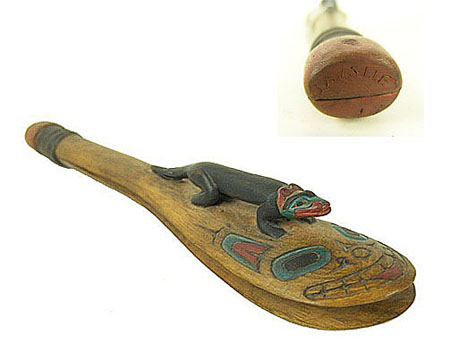
Owner: HWMC
Catalog#: NA-IDST-099
Clappers
Tlingit 'Wolf' Rattle
Southern Alaska and Northern British Columbia
Northwest Coast / Tlingit
Alder wood, pigment
ca. Late 1960s
Length: 12 in, Width: 2 – 2.5 in
Idiophone – Struck – Struck Directly – Clapper
Carved on bottom of handle: ‘LAVALLE’
A Tlingit polychrome wood clapper carved of alder wood in two spatulate pieces, each of which is thinly sectioned at the handle and bound together by leather strips. It is adorned with black, red, and blue pigments, with low-relief carving of an unidentified creature featuring large ovoid eyes, teeth showing, tongue protruded, a circular nose and ears. On the top part of the clapper is a wolf. The wolf carving is an extension of the top spatulate piece and not an attachment. The wolf, representing courage, is an emblem of the Kaguan-ton clan, a subdivision of the Shungoo-kaedi moiety of the Tlingit people.
Clappers are used chiefly by dancers. Rapid shaking of the performer’s hand causes the held upper half to repeatedly flex open and shut, producing a clacking sound. This clapper is made by Rich LaValle, a wood carver, who was adopted by the George family of Angoon (Tlingit). His Tlingit name is ‘Kut Daa Jaa Gu.
Rattles and clappers are an important aspect of the ceremonial and shamanic culture of Northwest Coast First Nations. They serve as a key source of percussion along with the drum, the voice, and the whistle. They are also a story-telling device, used to punctuate or intensify a moment, or can be a tool, used to calm or invigorate a dancer.
